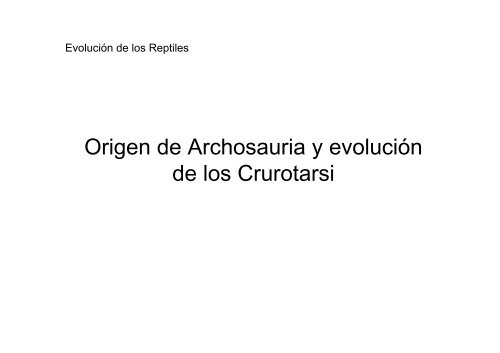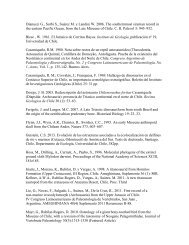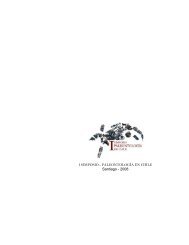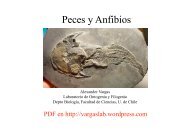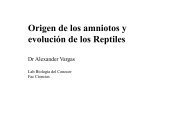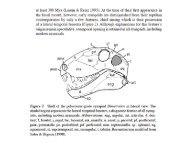Origen de Archosauria y evolución de los Crurotarsi
Origen de Archosauria y evolución de los Crurotarsi
Origen de Archosauria y evolución de los Crurotarsi
You also want an ePaper? Increase the reach of your titles
YUMPU automatically turns print PDFs into web optimized ePapers that Google loves.
Evolución <strong>de</strong> <strong>los</strong> Reptiles <br />
<strong>Origen</strong> <strong>de</strong> <strong>Archosauria</strong> y <strong>evolución</strong> <br />
<strong>de</strong> <strong>los</strong> <strong>Crurotarsi</strong>
<strong>Archosauria</strong> (crown group) <br />
Crocodylomorpha, Ornithodira
<strong>Archosauria</strong>: ACMR <strong>de</strong> aves y cocodri<strong>los</strong> <br />
Pan‐archosauria: todo <strong>los</strong> sauria que comparten un ACMR con <strong>los</strong> cocodri<strong>los</strong> que con <br />
las lagarAjas <br />
Apo‐archosauria
Los pan-archosaurios más universalmente reconocidos como tales son <strong>los</strong> Choristo<strong>de</strong>ra, que<br />
presentan huesos nasales más largos que <strong>los</strong> frontales, y más <strong>de</strong> 6 vertebras cervicales
Pan-archosauria<br />
Cervical ribs with 2 heads; concave-convex<br />
articulation of astragalus & calcaneum;<br />
premaxilla extends dorsally behind nares &<br />
exclu<strong>de</strong>s maxilla; teeth in sockets; neck with<br />
7-8 vertebrae; centra not <strong>de</strong>eply<br />
amphicoelous; pisiform usually absent in<br />
carpus; primitively, calcaneal tuber extends<br />
laterally beyond articulating surface of<br />
calcaneum (pulley for gastrocnemius –<br />
more upright position?).
Archosauromorpha: ACMR <strong>de</strong> protorosauria, archosauria y todos sus <strong>de</strong>scendientes<br />
PROLACERTIFORMES: Like early Lepidosauromorphs in<br />
reduction of temporal bar; squamosal reduced or ventral process<br />
that preclu<strong>de</strong>s streptostyly; agile terrestrial predators. Also<br />
inclu<strong>de</strong>s Tanystropheus, with very long neck composed of only<br />
6-7 vertebrae but twice length of trunk & relatively immobile,<br />
limbs poorly ossified; apparantly ate cephalopods.<br />
Prolacerta
El cuello arcosauromorfo:<br />
-Centros inclinados (vert 2-6)<br />
-Prezygapofises largas (verts 3-7)<br />
-costillas cervicales en forma <strong>de</strong> “arado” (3-6)
Más semejantes a archosauria en que se<br />
pier<strong>de</strong> el hueso septomaxilar (y<br />
vomeronasal asociado tb??) sin embargo<br />
otros archosauria (phytosauria) todavía<br />
tienen, pue<strong>de</strong>n ser eventos in<strong>de</strong>pendientes<br />
Posición elevada <strong>de</strong> la cabeza ina<strong>de</strong>cuada<br />
para sabo-olisquear?
Type A: (left si<strong>de</strong> of Bob) the septomaxilla is often sutured to the<br />
lacrimal and appears to be an extension of that bone. Alternatively,<br />
it has a long external, posterior process towards the orbit. In either<br />
case, it is probably associated with the nasolacrimal duct. In this<br />
morph, it may or may not have additional structure insi<strong>de</strong> the naris.<br />
Type B: the septomaxilla is entirely insi<strong>de</strong> the naris. It lies on the<br />
lateral or ventral inner surface, in contact with the un<strong>de</strong>rlying<br />
vomer. In this position it often bears a distinct dorsally or medially -<br />
directed process which, from the outsi<strong>de</strong>, appears to divi<strong>de</strong> the<br />
naris into anterior and posterior compartments.<br />
Type C: (right si<strong>de</strong> of Bob) the septomaxilla lies almost entirely<br />
external to the naris. It is sutured to the nasal and extends<br />
ventrally or laterally to partially obscure the naris.<br />
Perhaps the differences between these types may be explained by<br />
the different inductive influences these septomaxillae experience<br />
during <strong>de</strong>velopment. The Type A bone is seems to function as an<br />
extension of the lacrimal and/or the nasolacrimal duct. Type B<br />
works with the vomer to form the floor of the naris and the shunt<br />
out of the nasal passage to the vomeronasal organ, or possibly the<br />
choana. Type C is a conventional <strong>de</strong>rmal roofing bone which<br />
extends the nasal out over the naris. Thus, Types A, B, and C<br />
could be thought of as, respectively, nasolacrimal, vomeral and<br />
nasal septomaxillae. Our type <strong>de</strong>signations have some<br />
phylogenetic utility, but they are not infallible. In some cases, as<br />
we will see, the type flips back and forth in a way which would be<br />
unbecoming of a reliable synapomorphy.
Suchia <br />
Proterosuchidae <br />
ARCHOSAURIFORMES <br />
Euparkeria <br />
Erythrosuchidae <br />
Ornithosuchidae
Los Archosauriformes (“tecodontes”) son carnívoros y se caracterizan <br />
fácilmente por la presencia <strong>de</strong> una fenestra anteorbital. Los primeros conocidos <br />
son <strong>los</strong> Proterosuchia, <strong>de</strong>l pérmico tardío. Tienen la apariencia <strong>de</strong> un <br />
cocodrilo ágil (tamaño 1 m). Aquí, Proterosuchus (=Chasmatosaurus), <strong>de</strong>l <br />
triásico temprano. <br />
Fenestra anteorbital
PROTEROSUCHIDAE
Archosaurus Proterosuchidae<br />
Apertura pineal: primitivo!
Archosauriformes (thecodontia, apo-archosauria: fenestra anteorbital)<br />
-Dientes con bor<strong>de</strong>s aserrados<br />
-Diente caniniforme en el <strong>de</strong>ntario<br />
-Orbita mas alta que ancha, con el globo ocular en la parte superior<br />
-Mandíbulas macrocarnívoras: presas <strong>de</strong> mayor tamaño, fundamentalmente otros<br />
vertebrados. Matar y engullir algo <strong>de</strong> mayor tamaño<br />
a) La mandibula esta <strong>de</strong>splazada ventralmente para aumentar la “bocanada”<br />
b) Muscu<strong>los</strong> mandibulares modificados, más profundos al interior <strong>de</strong>l cráneo,<br />
quizás provoca la génesis <strong>de</strong> una osificación lateroesfenoi<strong>de</strong> anterior al<br />
neurocráneo<br />
c) Estos gran<strong>de</strong>s muscu<strong>los</strong> se insertan en una enorme <strong>de</strong>presion mandibular<br />
d) Músculo pterygoi<strong>de</strong>o se extien<strong>de</strong> a la parte superior <strong>de</strong>l paladar, <strong>de</strong>bajo <strong>de</strong>l<br />
ojo<br />
Craneo macrocarnivoro; Hocico largo que es alto, angosto y triangular en seccion transversal<br />
.<br />
El resto <strong>de</strong>l craneo en seccion transversal es trapezoidal (<strong>de</strong> la orbita hacia atras)<br />
“meatcleaver face” <strong>de</strong>sarrollada por varios macrocarnivoros, <strong>de</strong>predadores <strong>de</strong> tetrápodos
Hacia el final <strong>de</strong>l triásico más tremprano hacen su aparición <strong>los</strong> Erythrosuchidae como el Vjushkovia, <strong>de</strong> 2.5 m <strong>de</strong> <br />
Largo. Los cráneos <strong>de</strong> algunos erythrosuchidae alcanzaban más <strong>de</strong> 1 metro <strong>de</strong> largo. Hace su aparición la fenestra <br />
mandibular Xpica <strong>de</strong> <strong>los</strong> <strong>Archosauria</strong>. El rango <strong>de</strong> movimiento <strong>de</strong> las extremida<strong>de</strong>s es mayor, sugiriendo una posible <br />
capacidad facultaAva para una postura más erguida. El fémur se torna sigmoidal en contorno y aparece un siAo <strong>de</strong> <br />
inserción muscular, el cuarto trochanter, hacia la cara posterior <strong>de</strong>l tercio proximal <strong>de</strong>l fémur <br />
Fenestra mandibular <br />
Cuarto trochanter <br />
Femur <strong>de</strong> archosaurio <strong>de</strong>rivado<br />
(dinosaurio, Eoraptor)
Erythrosuchidae: origen <strong>de</strong> la pelvis triradiada
Proterochampsa <br />
Chañaresuchus
En la parte más tardía <strong>de</strong>l triásico temprano hace su aparición <br />
Euparkeria. Euparkeria es cercano a <strong>los</strong> <strong>Archosauria</strong>, grupo que incluye a todos <strong>los</strong> <br />
<strong>de</strong>scendientes <strong>de</strong>l ancestro común más reciente comparAdo por <strong>los</strong> cocodri<strong>los</strong> y las <br />
aves. Euparkeria fue <strong>de</strong>scubierto como una agregación <strong>de</strong> 10 especímenes subadultos, <br />
en un probable contexto social. La disminución <strong>de</strong> tamaño pue<strong>de</strong> relacionarse con la <br />
mayor agilidad, mayor uso <strong>de</strong> la conducta <strong>de</strong> huída
Euparkeria y Proterochampsidae son más similares a <strong>Archosauria</strong><br />
(crown) en que tienen dos filas parasagitales <strong>de</strong> osteo<strong>de</strong>rmos<br />
Un sistema elaborado <strong>de</strong> muscu<strong>los</strong> bajo estos osteo<strong>de</strong>rmos<br />
permite un “rebote” al galopar<br />
Sin embargo aún las arterias carótidas pasan por <strong>de</strong>bajo (en vez<br />
<strong>de</strong> encima) <strong>de</strong>l proceso <strong>de</strong>l basipterygoi<strong>de</strong>s, lo que les diferencia<br />
<strong>de</strong> <strong>los</strong> archosauria
<strong>Archosauria</strong> (crown group) <br />
Crocodylomorpha, Ornithodira <br />
o bien , Pan-Aves, y Pan Crocodylia. En esta clase estudiaremos la rama Pan-crocodylia!
Synapomorfías Arcosaurianas!<br />
-Corazon: a) Ventricu<strong>los</strong> divididos b) 3 valvulas semilunares c) Valvula lateral muscular <strong>de</strong>l orificio<br />
auricoloventricular <strong>de</strong>recho<br />
-“Buche”: estomago anterior muscularizado, en el q se acumulan piedras tragadas<br />
-Construyen nidos <strong>de</strong> vegetacion<br />
-Cuidado <strong>de</strong>l nido y <strong>de</strong> la cria<br />
-“Canto” para atraer pareja y <strong>de</strong>fen<strong>de</strong>r territorio<br />
-Vocalizaciones fetales/juveniles: sincronizan ec<strong>los</strong>ion, gatillan apertura <strong>de</strong>l nido, provocan cuidado<br />
parental, cohesion <strong>de</strong> “bandada’ entre juveniles<br />
-Respiran al correr: a) postura erguida, parasagital c) torso y filas <strong>de</strong> osteo<strong>de</strong>rmos reducen ondulaciones<br />
laterales d) pulmones gran<strong>de</strong>s y compartimentalizados e) respiración con flujo unidireccional <strong>de</strong>l aire
CRUROTARSI
Los Parasuchia (phytosauria), otras formas acuáAcas muy semejantes a <br />
cocodri<strong>los</strong>. Una caracterísAca fácilmente disAnAva es la posición retraída <br />
<strong>de</strong> las aperturas nasales, que se encuentran justo al frente <strong>de</strong> <strong>los</strong> ojos en <br />
un promontorio elevado
Nicrosaurus
Septomaxilar aún presente. Se<br />
<strong>de</strong>bate si el vomeronasal,<br />
ausente en cocodri<strong>los</strong> actuales,<br />
estaba presente o no.
Paleorhinus
Loa Phytosauridae son crurotarsi basales,<br />
todos <strong>los</strong> <strong>de</strong>más pertenecen a<br />
Rauisuchiformes (Crocodylomorpha,<br />
“Rauisiuchia”, Ornithosuchidae,<br />
Stagonolepidae (Aetosauria)<br />
SUCHIA ó RAUISUCHIFORMES. Characters: skull 3x<br />
width of acetabulum<br />
Rasgo clave: receso lagenar<br />
Mammals, crocodilians and dinosaurs<br />
in<strong>de</strong>pen<strong>de</strong>ntly evolved acute, pitchsensitive<br />
hearing by elongating the lagena<br />
(called the cochlea in mammals).
ORNITHOSUCHIDAE
large diastema between premaxilla and maxilla, with<br />
constriction accommodating two large <strong>de</strong>ntary teeth<br />
large antorbital fenestra with fossa;<br />
Los Ornithosuchidae se caracterizan por la gran <br />
reducción <strong>de</strong> sus extremida<strong>de</strong>s anteriores y un <br />
tobillo en el cual el calcáneo se proyecta hacia el <br />
astrágalo, al revés que en <strong>los</strong> <strong>de</strong>más crurotarsi. <br />
Esta condición se ha nombrado como “cocodrilo <br />
reverAdo”
RAUISUCHIA<br />
llegaron a medir 12 metros, cráneos tan gran<strong>de</strong>s como Tyrannosaurus rex <br />
antorbital fenestra tends to be keyhole-shaped; ribs with anterolaterally projecting flange on proximal<br />
portion; ilium low; acetabulum faces ventrally; supraacetabular crest present; osteo<strong>de</strong>rms not<br />
sculptured (reversal)
RAUISUCHIA. Prestosuchidae, Rauisuchidae + Poposauridae <br />
digits V with 2 Phalanges<br />
Arizonasaurus (Poposauridae)
A diferencia <strong>de</strong> <strong>los</strong> Ornithodira, la posición erguida <br />
en Rauisuchidae evolucionó por el cambio en la <br />
orientación <strong>de</strong>l acetábulo, más que por el cambio <br />
en la orientación <strong>de</strong>l extremo proximal <strong>de</strong>l fémur
Saurosuchus, Rauisuchidae <strong>de</strong> 5 M
Lotosaurus, es un notable <br />
Rauisuchidae herbívoro <strong>de</strong> <br />
China, sin dientes, provisto <br />
<strong>de</strong> vela dorsal
AETOSAURIA (Staganolepidae)<br />
Osteo<strong>de</strong>rmos “esculpidos”, como en cocodri<strong>los</strong>.<br />
Comparten caracteres craneales con<br />
crocodylomorpha, por lo que se ha propuesto que<br />
son grupo hermano<br />
limb bones very stout, with hypertrophied trochanters<br />
(<strong>de</strong>ltopectoral crest, 4th trochanter, intercondylar<br />
ridge of tibia & iliofibularis trochanter), manus IV with<br />
heavily armored; complete<br />
carapace with lateral & ventral<br />
armor; scutes flat, rectangular, with<br />
anterior articulating surface, but<br />
anteriorly- or posteriorly- projecting<br />
lappets absent; two pairs of<br />
paramedian dorsal osteo<strong>de</strong>rms,<br />
with more lateral series often<br />
bearing spines; paramedian scutes<br />
wi<strong>de</strong>r than long, sculptured, &<br />
without lappets ; dorsal osteo<strong>de</strong>rms<br />
with ornament typivally radiating<br />
from a boss near posterior margin<br />
[S92];
Small head; premaxilla upturned, anteriorly<br />
flattened; premaxilla without teeth anteriorly;<br />
<strong>de</strong>scending process of prefrontal absent; lower<br />
temporal fenestra reduced & triangular; leafshaped<br />
teeth; herbivorous;
Gracilisuchus, un Taxón problemáAcoaunque se ha sugerido cercanía a ornithosuchia actualmente <br />
se le consi<strong>de</strong>ra más cercano a Crocodilomorpha
GRACILISUCHUS
Erpetosuchus<br />
Erpetosuchus shares a number of rather specific characters with the Crocodylomorpha. These inclu<strong>de</strong><br />
parietals which are completely fused along the midline, <strong>los</strong>s of the postfrontal, and formation of a fairly<br />
complete secondary palate.
CROCODYLOMORPHA<br />
Characters: Skull massive and well-buttressed; no skull kinesis (skull absorbs force of strong, rapid bite);<br />
antorbital fenestrae small (c<strong>los</strong>ed in mo<strong>de</strong>rn forms); <strong>de</strong>scending process of prefrontal present;<br />
postfrontals absent; <strong>de</strong>scending process of squamosal absent; squamosal overhangs temporal region;<br />
anterior extension of quadrate; quadrate complex; quadrate contacts prootic; occiput solid, no or minor<br />
occipital fossae; exoccipital with lateral crest lying anterior to hypog<strong>los</strong>sal foramen; palate & braincase<br />
strongly integrated; ventral ramus of opisthotic makes extensive contact with prootic anteroventral to<br />
fenestra ovalis; middle ear elements pneumatized; crista vestibuli present; lagenar recess visible<br />
externally as prominence on wall of otic capsule [π$03]; Eustachian tubes at least partially encased in<br />
bone [π$03]; prootic not in broad contact with anterior of paroccipital process [π$03]; external foramen for<br />
abducens nerve solely within basisphenoid [π$03]; epipterygoid absent; basipterygoid processes<br />
enlarged [π$03]; pila antotica ossified by basisphenoid and laterosphenoid so that these elements are in<br />
contact anterior to trigeminal foramen [π$03]; secondary palate formed by maxillae & vomers [$P93];<br />
large anterior & posterior pterygoi<strong>de</strong>us muscles, oriented horizontally; parasphenoid rostrum forms<br />
vertically expan<strong>de</strong>d wedge [π$03]; skull bones pneumatized; 24 presacral vertebrae, 2 sacral vertebrae;<br />
accessory neural spine on mid-caudal vertebrae [π$03]; cartilaginous sternum (mo<strong>de</strong>rn forms) separates<br />
posteroventral extensions of coracoids; no clavicle (all suggest obligate quadruped); elongated carpals<br />
(ulnare and radiale) perhaps involved in giving extra swing to foreleg [$P93]; manus IV with 5 phalanges<br />
(reversal) [π$03]; pubic shaft length >3x width of acetabulum [π$03]; pubis exclu<strong>de</strong>d from acetabulum<br />
since Late Jurassic; acetabulum semi-perforate [π$03]; femoral head without distinct neck, but bent<br />
medially with parallel medial & lateral si<strong>de</strong>s [$P93]; metatarsal I length at least 85% length of Mt III [π$03];<br />
pes IV with
Ej, el pholidosauria Sarcosuchus<br />
antorbital fenestrae small (c<strong>los</strong>ed in mo<strong>de</strong>rn forms); <strong>de</strong>scending process of prefrontal present; postfrontals absent;<br />
squamosal overhangs temporal region<br />
Es un “alero” que se<br />
extien<strong>de</strong> <strong>de</strong>l escamoso<br />
sobre la región temporal
=============================
(Como tortugas)
Nothochampsa
Notochampsa
Protosuchus<br />
Triasico: pubis tien<strong>de</strong><br />
a quedaf excluido <strong>de</strong>l<br />
acetabulo
“alero”<br />
SPHENOSUCHIA<br />
Los mayoría <strong>de</strong> <strong>los</strong> rasgos crocodylomorfos se observan ya en <strong>los</strong> Sphenosuchia basales como <strong>los</strong> pequeños <br />
Terrestrisuchus y Saltoposuchus, muy ágiles, <strong>de</strong> extremida<strong>de</strong>s esbeltas. En Terrestrisuchus <strong>los</strong> huesos ulnare y <br />
radiale <strong>de</strong>l carpo ya son alargados <br />
Recapitulación? jejeje
SPHENOSUCHIA<br />
q y qj<br />
inclinados<br />
hacia<br />
anterior<br />
Receso <strong>de</strong>l<br />
canino<br />
mandibular<br />
todavía hay postfrontal<br />
Hay un paladar secundario corto <strong>de</strong><br />
extensiones <strong>de</strong> <strong>los</strong> maxilares
Los sphenosuchia aún tienen clavícula
PROTOSUCHIA<br />
trilophosaurus <br />
Nothochampsa <br />
(protosuquio)
Fosa nasal externa<br />
Nothochampsa (Orthosuchus)
Mesoeucrocodylia:<br />
Sculpturing along alveolar margin on lateral<br />
surface of maxilla<br />
Maxilla – maxilla contact on palate: complete<br />
Palatine secondary palate form palatal shelves<br />
Paired anterior palatal fenestra<br />
Axial neural spine height low, less than half<br />
centrum height and nearly horizontal<br />
Coracoid length subequal relative to scapula
Thallatosuchia<br />
Mesoeucrocodylia<br />
Dos grupos <strong>de</strong><br />
Mesoeucrocodylia:<br />
Thalattosuchia y<br />
Metasuchia<br />
Metasuchia
THALATTOSUCHIA Mesoeucrocodilya basales, marinos. 16 familias!<br />
Gran reduccion <strong>de</strong>l brazo en<br />
metriorhynchidae
THALATTOSUCHIA: TELEOSAURIDAE<br />
Osteo<strong>de</strong>rmos <br />
Gran tamaño <strong>de</strong> la<br />
apertura tempora<br />
superior<br />
Los Teleosauridae se recuperan <strong>de</strong> sedimentos marinos y poseen <br />
un hocio alargado con pientes punzantes claramente piscívoro. <br />
Poseen amadura dérmica
Pelagosaurus, un <br />
Metriorhynchidae primiAvo <br />
Crocodylia <br />
Familia Metriorhynchidae <br />
Metriorhinchus casamiquelai <br />
Jurásico <strong>de</strong> la II Región
Dakosaurus (metriorhynchidae)
Metasuchia: Nothosuchia + Neosuchia<br />
Large and aligned neurovascular foramina on<br />
lateral maxillary surface<br />
Position of first enlarged maxillary teeth second<br />
or third alveoli<br />
Posterior edge of quadrate body strongly<br />
concave<br />
Dentary extension beneath mandibular fenestra<br />
absent<br />
Cervical hypapophyses present only in cervical<br />
vertebrae<br />
Pubis completely exclu<strong>de</strong>d from acetabulum<br />
Square dorsal osteo<strong>de</strong>rms
Nothosuchia: pequeños cocodri<strong>los</strong> <strong>de</strong> postura muy erguida, ágiles, rostro corto, y <strong>de</strong>nAción heterodonta, posiblemente <br />
herbívora. (ej., Chimaerosuchus, <strong>de</strong> china). ConAene formas latamente <strong>de</strong>rivadas; Araripesuchus se aproxima al notosuquio <br />
ancestral <br />
Notosuchia:<br />
Nothosuchus<br />
Depression on anterodorsal surface of postorbital for a palpebral element<br />
Jaw articulation below maxillary tooth row<br />
Straight anterior edge of dorsal parasagittal osteo<strong>de</strong>rms<br />
Araripesuchus
Simosuchus
Yacarenani<br />
(sí, todavía estamos en Nothosuchia)
Baurusuchus 4 m<br />
Sphagesaurus<br />
Los Baurusuchia y Sphagesauridae son<br />
reconocidos por su cráneo profundo y<br />
diferenciación <strong>de</strong>ntaria que recuerda<br />
algunos synapsidos
Armadil<strong>los</strong>uchus Sphagesauridae
Segun Sereno y Larsson, Baurusuchia<br />
y sphagesauridae son NOTOSUCHIA<br />
Los Sebecia son Neosuchia, más<br />
cercanos a cocodri<strong>los</strong> mo<strong>de</strong>rnos<br />
Neosuquia:<br />
Dermal bone overhang about the<br />
supratemporal fenestra present only medially<br />
Quadratojugal ornamentation at its base<br />
Ventrolateral edge of maxilla in lateral view:<br />
double convexity (“festooned”)
Los Trematochampsidae o Sebecidae son gran<strong>de</strong>s cocodri<strong>los</strong> terrestres, <strong>de</strong> extremida<strong>de</strong>s alargadas, que <br />
poseían dientres palanados y aserrados muy semejantes a <strong>los</strong> dientes <strong>de</strong> dinosaurios carnívoros, condición <br />
que se ha <strong>de</strong>nominado como “zifodonte”, y que luego evolucionó <strong>de</strong> manera convergente en otros <br />
neosuquios <br />
Trematochampsidae <br />
Sebecus <br />
Fines <strong>de</strong>l Cretácico, Eoceno
Frontal orbital margin dorsally upturned<br />
External nares orientation dorsal<br />
Pterygoid secondary palate thin shelf that<br />
does not meet<br />
Primary pterygoid palate forms posterior,<br />
lateral, and part of the anterior margin of<br />
the internal (secondary) choana<br />
<strong>de</strong>ntary symphysis in ventral view Ushaped<br />
smoothly curving anteriorly<br />
Vertebral centra spool shaped<br />
Tibia shorter than femur
PHOLIDOSAURIDAE<br />
Sarcosuchus es un Pholidosaurio gigantesco <br />
(12 M) <strong>de</strong>l <br />
cretácico inferior <strong>de</strong> África
Pholidosauria son más cercanos a Crocodylia:<br />
Antorbital fenestra absent<br />
Dermal bone overhang about the supratemporal fenestra present about all but the anteromedial<br />
corner<br />
Posterolateral overhanging rim of supratemporal fossa present and temporal-orbital foramen<br />
partially occlu<strong>de</strong>d from dorsal view<br />
5 dientes premaxilares<br />
Position of first enlarged maxillary teeth fourth or fifth alveoli<br />
Supra acetabular crest absent
Dyrosaurus
Goniopholis
Stomatosuchus es un Posible Eucrocodylia basal, <br />
con vértebras procélicas pero paladar <br />
“mesosuquio” <br />
Splenial not involved in mandibular symphisis
Crocodylia (eusuchia) <br />
Actualmente, <strong>los</strong> Eusuquia están representados por Gavialidae, y <br />
Alligatoridae + Crocodylidae. Los Eusuquia (verda<strong>de</strong>ros cocodri<strong>los</strong>) <br />
ya eran abundantes en el cretácico inferior. <br />
Internal nares completely surroun<strong>de</strong>d by pterygoids; centra of almost all vertebrae procoelous. 4-chambered heart, but<br />
effectively 3 compartments.
Gavialis <br />
Los Gaviales evi<strong>de</strong>ncian otro evento <strong>de</strong> <br />
<strong>evolución</strong> <strong>de</strong> un hocico alargado y <br />
piscívoro
PrisAchampsidae: <br />
Son gran<strong>de</strong>s formas <strong>de</strong> cocodri<strong>los</strong> terrestres <strong>de</strong>l <br />
eoceno <strong>de</strong> Sudamérica y Australia, con garras romas y <br />
excavadas en forma <strong>de</strong> pezuña. Son Eusuquios que <br />
convergieron con <strong>los</strong> Sebecidae en la <strong>evolución</strong> <strong>de</strong> una <br />
<strong>de</strong>nAción zifodonta
Los Alligatoridae y Crodylidae actauels pue<strong>de</strong>n disAnguirse fácilmente <br />
por la ausencia en Alligatoridae <strong>de</strong> dientes <strong>de</strong> la mandíbula que sobresalgan por encima <strong>de</strong>l maxilar. En <br />
Alligatoridae, existe una fosa que alberga al colmillo <strong>de</strong>ntario <strong>de</strong> mayor tamaño. En vista superior, el hocico <strong>de</strong> <strong>los</strong> <br />
Alligatoridae es redon<strong>de</strong>ado, en tanto que en <strong>los</strong> crocodylidae, se observa una muesca para el colmillo <strong>de</strong>ntario (4to)
CROCODYLIDAE<br />
Tomistomines have 20 or 21 teeth on<br />
each si<strong>de</strong> si<strong>de</strong>, and, as with the<br />
Crocodylinae, the fourth tooth remains<br />
visible when the mouth is c<strong>los</strong>ed. This is<br />
a relatively recent group, appearing<br />
sud<strong>de</strong>nly during the Miocene epoch<br />
The Crocodylinae, or true crocodiles,<br />
inclu<strong>de</strong> 12 living species. These<br />
crocodiles have 14 or 15 teeth on each<br />
si<strong>de</strong> of the mouth. The fourth tooth fits<br />
into a pit in the upper jaw, but remains<br />
visible when the mouth is c<strong>los</strong>ed.
“falso gavial”: Más cercano <br />
a Crocodylidae que a Gavialis <br />
Tomistoma <br />
La filogenia molecular confirma que Tomistoma consAtuye un evento in<strong>de</strong>pendiente <strong>de</strong> adquisición <strong>de</strong> un hocico piscívoro alargado <br />
(hipótesis a la <strong>de</strong>recha)
Crocodylus
Mekosuchus presenta caracterísAcas tanto <strong>de</strong> Alligatoridae como <br />
Crocodylidae. Se trata <strong>de</strong> un linaje <strong>de</strong> Eucocodrylia primiAvos que <br />
sobrevivió hasta la reciente intervención <strong>de</strong> humanos hace 3000 <br />
años en Nueva Caledonia
UN MEKOSUCHIDAE CON<br />
DENTICION “ZIFODONTE”
Alligator missisipensis
ALLIGATORIDAE<br />
The snout is broad and only mo<strong>de</strong>rately<br />
elongated, and not <strong>de</strong>marcated from the rear of<br />
the skull. The nasal bones extend forward to<br />
meet the premaxillae (snout / upper jaw bones).<br />
There are 17-22 teeth on either si<strong>de</strong> of each jaw.<br />
The fourth tooth of the lower jaw fits into a pit in<br />
the upper jaw and is invisible when the mouth is<br />
c<strong>los</strong>ed. During the past this group ranged wi<strong>de</strong>ly<br />
through Europe, Asia, North and South America.
Deinosuchus, <strong>de</strong>l cretácico tardío, con afinida<strong>de</strong>s a Alligatoridae
Aligator Chino <br />
Alligator sinensis
Alligatoridae: <br />
Caimaninae <br />
Purusaurus
PlasAcidad evoluAva y <br />
convergencia <strong>de</strong> la forma <strong>de</strong> la <br />
cabeza en Eucrocodylia


